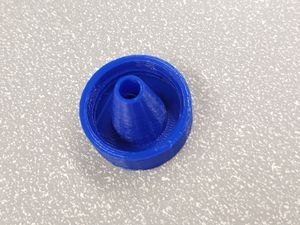
This project is appropriate because it uses post-consumer containers and an easily 3-D printable part to replace the need for manufacturing new sharps containers. This is a remixed cap designed to screw onto a two-liter coke bottle so that used hypodermic needles can be deposited into the container. The tapered funnel-like shape on the underside of the cap is to allow needles to more freely enter the container with reduced risk of coming back out. this lid was designed to screw on to ensure a tight fit so the lid doesn't come off.[1] This also re-uses post-consumer plastic containers to reduce plastic waste. Due to the cheapness of this product, it can be used anywhere in the world.
Bill of Materials
- Provide a full BOM -- Materials needed for fabrication of device and alternative materials if they are not available, prices/sources of non-printable parts
- Upload and link to all source files from open source CAD
- Upload and link to all STLs
- STL and OpenSCAD source can be found here
Tools needed
- MOST Delta RepRap or similar RepRap 3-D printer
- OpenSCAD thread library click the link right under the "OpenSCAD modules" heading. I mainly used this to understand what the threading parameters were called in OpenSCAD.
- calipers to measure ID and OD of bottle top, thread pitch, height.
- razor blade to assist with removing print from bed
Skills and knowledge needed
- aquire a basic knowledge of threading terms and what they mean threading terminology the major diameter is the same as OD in the scad file, and minor diameter is the ID.
Technical Specifications and Assembly Instructions
- Provide directions for print/assembly - be detailed enough in your "how to" to ensure that someone could construct the device from your description. Consider the elegance of IKEA like instructions.
- Print time estimate: 48 min
- STL file was sliced in Cura Lulzbot 3.2.27 (I added a deltabot printer as a new machine)
- Model size was scaled up by 2% (use scale multiplier 102% in Cura) to account for possible shrinkage
- Model included funnel shape underneath cap to minimize possibility of needles coming back out
- Heated print bed was NOT used for printing this
- I used a brim, however
- Printing parameters:
1. Initial layer height: 0.4 mm 2. Layer height: 0.2 mm 3. Infill: 100% 4. Print temperature: 200°C 5. (filament) diameter: 1.75 mm 6. Print speed: 30mm/s 7. Brim width: 8mm 8. Brim line count: 5
- Assembly time estimate: 15 sec
-
Modified sharps container
-
top view
-
cap
Common Problems and Solutions
- Include common mistakes/problems to avoid in building your OSAT and how to overcome them
Cost savings
- If your solution is not a low cost one then it is not really appropriate.
- Estimate your costs
- 4 grams of PLA filament ~ $0.08
- two-liter coke bottle: anywhere from free to $1.25
- Cheapest commercial equivalent for sharps container $5.89
- Calculate $ savings and % savings
if bottle = free: savings = $5.81 = 98.6% savings if bottle = $1.25: savings = $4.56= 77.4% savings
Benefited Internet Communities
- Name and add links to at least 5 using single brackets around [url name]
Field Ready [1] Medic Mobile [2] World Health Organization [3] Amref Health Africa [4] World Pediatric Project [5]
References
</nowiki>


